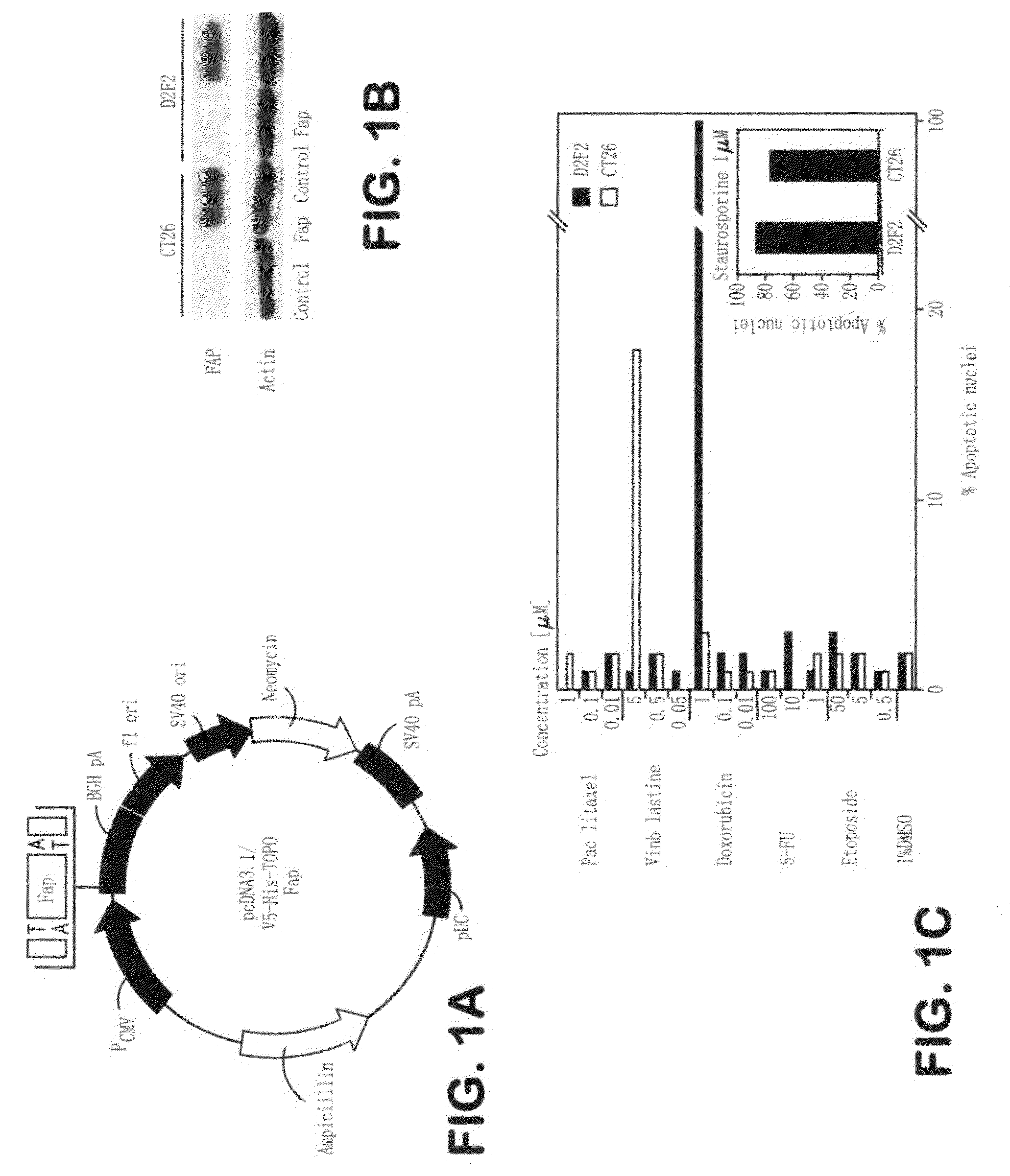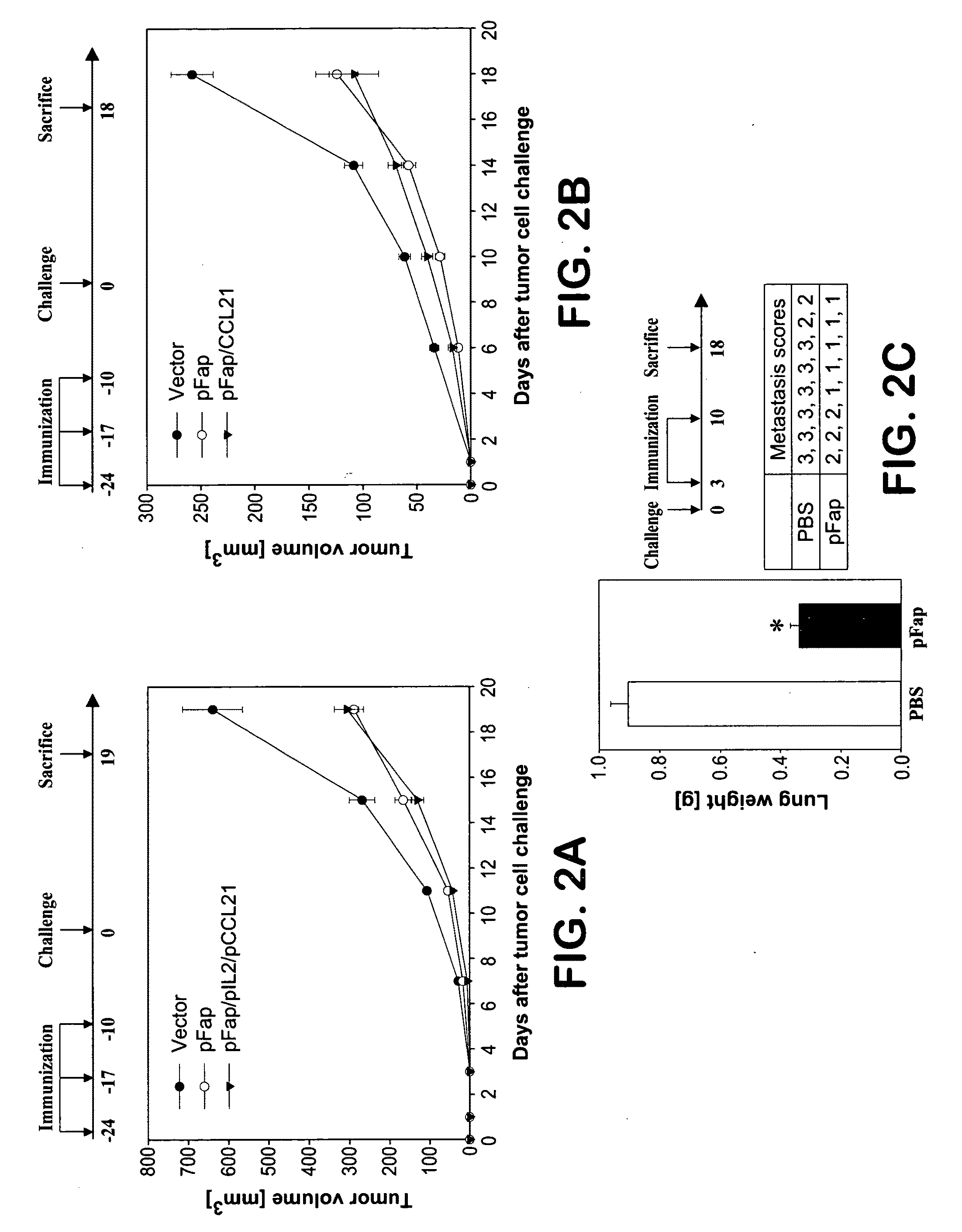DNA composition against tumor stromal antigen FAP and methods of use thereof
a technology of stromal antigen and composition, which is applied in the field of deoxyribonucleic acid (dna) compositions, can solve the problems of inactivation, not all infectious agents can be readily cultured, and difficult to identify the target of tumor antigen, so as to prolong the antitumor effect, suppress the dissemination of established pulmonary metastases, and ensure the effect of immunotherapy reliability
- Summary
- Abstract
- Description
- Claims
- Application Information
AI Technical Summary
Benefits of technology
Problems solved by technology
Method used
Image
Examples
example 1
Preparation of DNA Composition 1 Encoding Murine FAP
[0115]A cDNA (SEQ ID NO: 3, FIG. 9; provided by Dr. J. D. Cheng) encoding murine FAP (SEQ ID NO: 4, FIG. 10), was subcloned into the EcoRI restriction site of the pcDNA3.1 / V5-His-TOPO vector (Invitrogen, San Diego, Calif.), to afford the eukaryotic expression vector pcDNA3.1-FAP (pFAP) (see FIG. 1, Panel A). The correct expression of the 95 kDa FAP protein from the vector was demonstrated by Western-blotting of cell lysates from transiently transfected CT26 colon carcinoma cells, which do not express FAP by themselves (FIG. 1, Panel B). This was also the case for transiently transfected D2F2 breast carcinoma cells. For transient transfections, CT26 and D2F2 cells were electroporated as described previously (See Loeffer et al., FASEB, J. 2001, 15: 758-767, incorporated herein by reference). Protein expression of FAP was demonstrated by Western blotting with a polyclonal rabbit anti-murine FAP antibody (provided by Dr. J. D. Cheng).
[...
example 2
Preparation of DNA Composition 2 Encoding Murine FAP, Murine IL-2, and Murine CCL21
[0118]cDNAs encoding murine IL-2 (DNA SEQ ID NO: 5), from ATCC, Accession #39892, Manassas, Va., and murine CCL21a (DNA SEQ ID NO: 7) from Invitrogen, San Diego, Calif., were subcloned into the murine pFAP vector of Example 1, by the same general procedure described in Example 1. RE88 Salmonella typhimurium were transformed with the resulting vector (pFAP / IL-2 / CCL21) by the procedure described in Example 1 to provide a solution of DNA Composition 2 containing a DNA construct that operably encodes murine FAP, murine IL-2, and murine CCL21a, incorporated in an attenuated Salmonella typhimurium vector.
example 3
Evaluation of DNA Compositions of the Invention in Murine Models of Colon and Breast Cancer
[0119]Oral immunization, tumor cell challenge and treatment with doxorubicin. For experiments in a prophylactic setting, BALB / c mice (n=8) were treated three times at about 1-week intervals by oral gavage with about 100 μl PBS containing about 109 S. typhimurium (AroA− dam−) transformed with plasmid vectors encoding murine FAP (DNA Composition 1 of Example 1), murine FAP, IL-2 and CCL21 (DNA Composition 2 of Example 2), or control vaccine of Example 1, by methods described in Niethammer et al., Nat. Med., 2002, 8: 1369-1375. Animals were challenged about 10 days later by subcutaneous (s.c.) injection of about 3×104 CT26 colon carcinoma cells in the left front flank or by orthotopic (o.t.) injection of about 3×105 D2F2 breast cancer cells in the left, second lowest mammary fat pad.
[0120]Tumor volume (in mm3) was calculated by measuring the tumor in 2 dimensions (i.e., length and width, in milli...
PUM
| Property | Measurement | Unit |
|---|---|---|
| molecular weight | aaaaa | aaaaa |
| weight | aaaaa | aaaaa |
| diameter | aaaaa | aaaaa |
Abstract
Description
Claims
Application Information
 Login to View More
Login to View More - R&D
- Intellectual Property
- Life Sciences
- Materials
- Tech Scout
- Unparalleled Data Quality
- Higher Quality Content
- 60% Fewer Hallucinations
Browse by: Latest US Patents, China's latest patents, Technical Efficacy Thesaurus, Application Domain, Technology Topic, Popular Technical Reports.
© 2025 PatSnap. All rights reserved.Legal|Privacy policy|Modern Slavery Act Transparency Statement|Sitemap|About US| Contact US: help@patsnap.com



